英语中六大从句用法总结汇编
英语从句用法小结
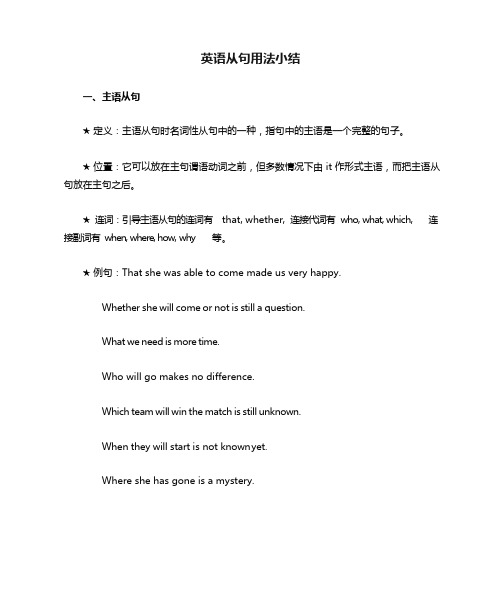
英语从句用法小结一、主语从句★ 定义:主语从句时名词性从句中的一种,指句中的主语是一个完整的句子。
★ 位置:它可以放在主句谓语动词之前,但多数情况下由 it 作形式主语,而把主语从句放在主句之后。
★连词:引导主语从句的连词有that, whether, 连接代词有who, what, which, 连接副词有 when, where, how, why 等。
★ 例句:That she was able to come made us very happy.Whether she will come or not is still a question.What we need is more time.Who will go makes no difference.Which team will win the match is still unknown.When they will start is not known y et.Where she has gone is a mystery.How this happened is not clear.Why he did that wasn ’t.★ 引导主语从句的 that 不作成分,但不能省略。
★ 由 it 作形式主语,常用句型有:It is + 名词/形容词/过去分词+主语从句It is still a question whether she will come or not. It is strange that you should like him.It is still unknown which team will win the match. 此外,还有以下常用结构:It turned out that … 结果是…It has been found that …已经发现…It has been p roved that …已经证明…It happened/occurred that …恰好…It is well-known that …据说…It is said/reported that …据说/据报道…It must be pointed o ut that …必须指出…It doesn ’t matter whether …是否…都没关系It makes no d ifference whether …是否…毫无区别二、表语从句★ 定义:表语是一个完整的句子。
英语六大从句用法总结

英语中六大从句用法总结从句是指用于复合句中担当某个句子成分的主谓结构。
虽说从句自身的句子结构是完整的,但是它不能视为独立的句子,因为它离开了主语就无法独立、完整地表达意思。
按其所能表达的意义而言,它相当于一个词或是一个词组.按从句的句子功能划分(也就是按从句在句子中所担任的成分来划分),从句可分为:主语从句、宾语从句、表语从句、同位语从句、定语从句和状语从句。
1.主语从句1)主语从句可直接位于主语的位置,如果从句较长,谓语又较短,可用it作形式主语,而将从句放在句末。
常见的句型有:*It is a fact\a pity\a question\good news that...*It seems\appears\happened\has turned out that...*It is clear\important\likely\possible that...*It is said\reported\estimated\has been proved that...It is said that comic books create a connection between people of the same generation.It seems that the performance is very useful.2)what引导的主语从句表示“...的东西时”,一般不用it作形式主语。
What we lack is experience.3)what,who,when,why,whether等词含有各自的疑问意义,但它们引导的主语从句,都用陈述语序。
How the plan is to be carried out should be discussed again.I did know why I felt like crying.2.宾语从句1)宾语从句可位于及物动词、介词和某些形容词后。
从句的用法归纳总结
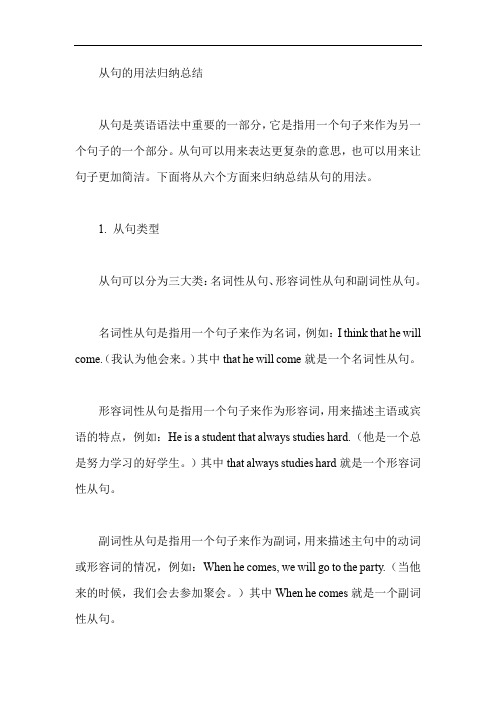
从句的用法归纳总结从句是英语语法中重要的一部分,它是指用一个句子来作为另一个句子的一个部分。
从句可以用来表达更复杂的意思,也可以用来让句子更加简洁。
下面将从六个方面来归纳总结从句的用法。
1. 从句类型从句可以分为三大类:名词性从句、形容词性从句和副词性从句。
名词性从句是指用一个句子来作为名词,例如:I think that he will come.(我认为他会来。
)其中that he will come就是一个名词性从句。
形容词性从句是指用一个句子来作为形容词,用来描述主语或宾语的特点,例如:He is a student that always studies hard.(他是一个总是努力学习的好学生。
)其中that always studies hard就是一个形容词性从句。
副词性从句是指用一个句子来作为副词,用来描述主句中的动词或形容词的情况,例如:When he comes, we will go to the party.(当他来的时候,我们会去参加聚会。
)其中When he comes就是一个副词性从句。
2. 从句引导词从句的引导词有很多种,不同的引导词可以引导不同类型的从句。
常用的引导词有:* that:可以引导名词性从句和形容词性从句,但是不能引导副词性从句;* what:可以引导名词性从句;* who:可以引导名词性从句和副词性从句;* whom:可以引导名词性从句;* which:可以引导名词性从句;* where:可以引导副词性从句;* when:可以引导副词性从句;* why:可以引导名词性从句;* how:可以引导名词性从句和副词性从句。
3. 从句语序在英语中,主句和从句的语序一般是不同的。
主句通常采用陈述语序,而从句则可以采用疑问语序或倒装语序。
例如:Do you know where he lives?(你知道他住在哪里吗?)其中where he lives就是一个名词性从句,采用了疑问语序。
各种从句的用法和解析(英语)
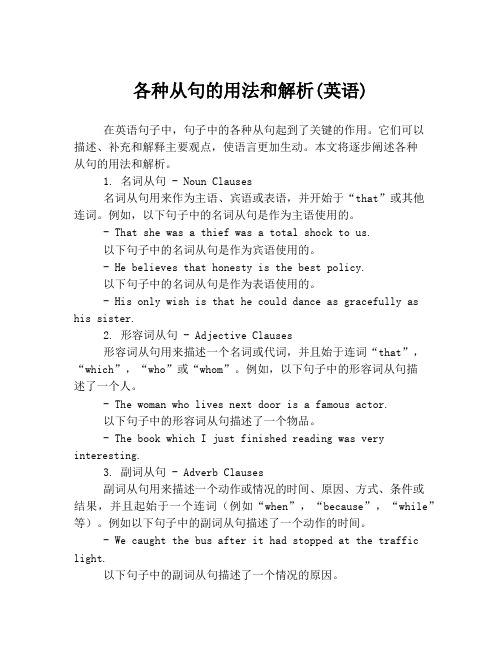
各种从句的用法和解析(英语)在英语句子中,句子中的各种从句起到了关键的作用。
它们可以描述、补充和解释主要观点,使语言更加生动。
本文将逐步阐述各种从句的用法和解析。
1. 名词从句 - Noun Clauses名词从句用来作为主语、宾语或表语,并开始于“that”或其他连词。
例如,以下句子中的名词从句是作为主语使用的。
- That she was a thief was a total shock to us.以下句子中的名词从句是作为宾语使用的。
- He believes that honesty is the best policy.以下句子中的名词从句是作为表语使用的。
- His only wish is that he could dance as gracefully as his sister.2. 形容词从句 - Adjective Clauses形容词从句用来描述一个名词或代词,并且始于连词“that”,“which”,“who”或“whom”。
例如,以下句子中的形容词从句描述了一个人。
- The woman who lives next door is a famous actor.以下句子中的形容词从句描述了一个物品。
- The book which I just finished reading was very interesting.3. 副词从句 - Adverb Clauses副词从句用来描述一个动作或情况的时间、原因、方式、条件或结果,并且起始于一个连词(例如“when”,“because”,“while”等)。
例如以下句子中的副词从句描述了一个动作的时间。
- We caught the bus after it had stopped at the traffic light.以下句子中的副词从句描述了一个情况的原因。
- Since it was raining heavily, we decided to stay at home.以下句子中的副词从句描述了一个条件。
英语从句用法小结

英语从句从句有主语从句、表语从句、宾语从句、同位语从句、定语从句和状语从句6类。
前四类由于主语从句、表语从句、宾语从句及同位语从句在句子的功用相当于名词,所以通称名词性从句;后两类定语从句和状语从句功用相当于形容词,称为形容词性从句。
状语从句还可以分为条件状语从句、原因状语从句、方位状语从句和时间状语从句。
1.主语从句(Subject Clause):用作主语的从句叫主语从句。
引导主语从句的关联词有从属连词、疑问代词、疑问副词、缩合连接代词、缩合连接副词等。
2.表语从句(Predicative Clause):用作表语的从句叫表语从句。
引导表语从句的关联词与引导主语从句的关联词大都一样。
3.宾语从句(Object Clause):在句子中起宾语作用的从句叫做宾语从句.宾语从句分为动词的宾语从句,介词的宾语从句和形容词的宾语从句。
一、主语从句★定义:主语从句时名词性从句中的一种,指句中的主语是一个完整的句子。
★位置:它可以放在主句谓语动词之前,但多数情况下由it作形式主语,而把主语从句放在主句之后。
★连词:引导主语从句的连词有that, whether, 连接代词有who, what, which, 连接副词有when, where, how, why等。
★例句:That she was able to come made us very happy.Whether she will come or not is still a question.What we need is more time.Who will go makes no difference.Which team will win the match is still unknown.When they will start is not known yet.Where she has gone is a mystery.How this happened is not clear.Why he did that wasn’t.★引导主语从句的that不作成分,但不能省略。
英语的从句类型与用法总结

英语的从句类型与用法总结
英语的从句类型与用法总结如下:
1.定语从句:在复合句中,修饰名词或代词的从句叫定语从句,被修饰的名词或代词叫先行词,引导定语从句的有关系代词(who, whom, whose, which, that 等)和关系副词(where, when, why等),关系代词和关系副词在定语从句中担任句子成分。
2.状语从句:由从句担任的状语,在句子中可修饰谓语(或其它动词)、形容词、副词或是整个句子,它可以用来表示时间、地点、原因、目的、结果、条件、方式、比较、让步等。
3.名词性从句:在句子中起名词作用的句子叫名词从句(Noun Clauses)。
名词从句的功能相当于名词词组,它在复合句中能担任主语、宾语、表语、同位语、介词宾语等,因此根据它在句中不同的语法功能,名词从句又可分别称为主语从句、宾语从句、表语从句和同位语从句。
英语中总共有六大从句-区分方法

英语中总共有六大从句,区分方法,用法,及例子如下:1.主语从句1)主语从句可直接位于主语的位置,如果从句较长,谓语又较短,可用it作形式主语,而将从句放在句末.常见的句型有:*It is a fact\a pity\a question\good news that...*It seems\appears\happened\has turned out that...*It is clear\important\likely\possible that...*It is said\reported\estimated\has been proved that...It is said that comic books create a connection between people of the same generation.It seems that the performance is very useful.2)what引导的主语从句表示“...的东西时”,一般不用it作形式主语.What we lack is experience.3)what,who,when,why,whether等词含有各自的疑问意义,但它们引导的主语从句,都用陈述语序.How the plan is to be carried out should be discussed again.I did know why I felt like crying.2.宾语从句1)宾语从句可位于及物动词、介词和某些形容词后.连词that常可省略.介词后一般接疑问词引导的宾语从句.in that(因为),except that(除了),but that(只是)已构成固定搭配,其他介词后一般不接that引导的宾语从句.*I promised that I would change the situation.*All this is different from what American young people would say about friendship.*He is certain that watching so much television is not good for children.*This article is well-written except that it is a bit too long.2)宾语从句后如有宾补,要用形式宾语it来代替,而把宾语从句移至宾补之后.He has made it clear that he would not change his mind.3)在think,believe,suppose,expect等动词后的宾语从句中,如果谓语是否定的,一般将否定词移至主句谓语上,宾语从句则变成肯定形式.He didn't think that the money was well spent.3.表语从句表语从句出现在结构为“主语+系动词+表语从句”的句子中.表语从句除可用that,what,when,why,whether,how等引导外,还可由because,as if(though)等引导.that 常可省略.如主句主语为reason,只能用that引导表语从句,不可用because.Perhaps the most important thing to remember is that there is no one common type of life in America.The reason why so many people died there is that there were not enough food supplies.It looks as if successful international cultural communication will make the world smaller.4.同位语从句同位语从句用于对前面出现的名词作进一步说明,一般用连词that引导,由于先行名词的意义不同,也可用whether,who,when,where,what,why,how等引导.常见的先行名词有fact,idea,belief,news,hope,conclusion,evidence,suggestion,order,problem,report,de cision.有时由于谓语较短,将同位语从句位于谓语之后.She finally made the decision that she would join the fashion show.I had no idea how many books I could borrow at a time.The news came that their team had won the championship.5.定语从句定语从句所修饰的先行词可以是名词或代词,也可以是一个句子.定语从句通常位于先行词之后,由关系代词或关系副词引导.*限制性定语从句限制性定语从句修饰先行词,对先行词起修饰作用,紧接先行词之后,无逗号,若省去,原句意思不完整.引导定语从句的关系代词有who,whom,whose,which,that等.who,whom,whose 用于指人,whose有时也可指物,相当于of which;which用于指物;that既可指人也可指物,但只用于限制性定语从句中.关系代词除了引导定语从句,替代先行词外,还在从句中担任主语、宾语、定语等.The computers and cables which make up the Internet are owned by people and organizations.Those who live alone or who are sick may have trouble in getting close to other people.The girl whose parents died in an accident is living with her grandmother.1)当先行词是all,anything,everything,something,nothing等不定代词或先行词前有first,last,any,few,much,some,no,only以及形容词最高级修饰时,只能用关系代词that引导从句.That is all that I've heard from him.He's the first person that I'm going to interview this afternoon.2)关系代词的省略在从句中作宾语的关系代词常可省略.关系代词紧跟介词,作介词宾语时不可用that,只可用which或whom引导从句,并且不可省略,但当介词位于宾语从句句末时,作为介词宾语的关系代词仍可用that,也可省略.This is one of those things with which we have to put up.This is one of those things (which\that) we have to put up with.3)引导定语从句的关系副词有when,where,why等.关系副词在从句中作状语,意义上相当于一个“介词+which”的结构.Even in comic books where(=in which) there are no words,the stories are fully expressed through the drawings.No one knows the reason why(=for which) he was so angry that day.5.定语从句*非限制性定语从句非限制性定语从句既可修饰先行词,也可修饰整个主句,起补充说明作用,与主句之间有逗号隔开,若省去,原句意思不受影响.不可用that引导非限制性定语从句.关系词不可省略. Every object has a gravitational pull,which is rather like magnetism.*“介词+which\whom\whose”引导的定语从句“介词+which\whom\whose”可引导限制性定语从句,也可引导非限制性定语从句,该结构中介词的选择取决于从句谓语动词的固定搭配,或先行词的习惯搭配.This is the computer on which he spent all his savingsIt is written by a person with whom we are all familiar.*as引导的定语从句as引导的定语从句主要用于“such...as”及“the same...as”的结构中,代替先行词是人或物的名词.as引导非限制性定语从句时,代替整个主句,从句可位于主句之前、之后或中间. These are not such problems as can be easily solved.(as代替先行词problems)As is mentioned above,no single company or group can control what happens on the Internet.(as代替主语)6.状语从句*时间状语从句引导时间状语从句的从属连词和词组有:1)when,whenever,while,as,after,before,since,till,until,once等.We have learnt quite a lot about it since we came here.2)as soon as,hardly(scarcely)...when,no sooner...than,each(every) time,the moment,immediately(that)等.As soon as I sent an e-mail message,I received positive responses.The moment he heard the good news,he jumped with joy.*地点状语从句引导地点状语从句的连词是where,wherever.Wherever she went,she took her little daughter with her.*原因、结果和目的状语从句1)引导原因状语从句的从属连词有:because,as,since,now(that),seeing that,considering that,in that等.Considering that he is a freshman,we must say he is doing well.2)引导结果状语从句的连词有:so...that,such...that,so that,that,so等.Mickey Mouse is so attractive that the children are reluctant to leave.3)引导目的状语从句的连词有:so that,in order that,for fear that,lest等,从句常使用may,might,can,could,would等情态动词.We got up early this morning so that we could catch the first bus to the railway station.*条件和让步状语从句1)引导条件状语从句的连词和词组有if,unless,as(so) long as,on condition that,in case,provided(providing) that,supposing等.As long as you have the right equipment,you can use a telephone line to transmit computer data.2)引导让步状语从句的连词和词组有though,although,whether,even though,even if,no matter what(when,how...),whatever(whenever,wherever,however.)等.though,even if 等引导状语从句可转换成含有as的部分倒装结构,具有强调意义.其结构为“形容词(副词、动词、名词)+as+主语+谓语”.No matter what you may say,I would not change my mind.Young as he is,he is quite experienced in this work.(=though he is young)Child as he is,he can speak English fluently.(=though he is a child)*方式状语从句引导方式状语从句的连词有as,just as,as if,as though等.as if,as though引导的状语从句中,谓语动词常用虚拟语气,表示与事实相反.The young man made the experiment just as the teacher had taught him.Everything went on as usual as if nothing had happened.。
英语的从句类型与用法总结资料

英语的从句类型与用法总结资料从句是由一个或多个词组成的句子,可以作为句子的一部分。
从句有多种类型和用法。
以下是一些常见的从句类型及其用法的总结资料:1. 名词从句(Noun Clauses):- 作主语:What he said was true.- 作表语:The question is whether we should go or not.- 作宾补:She made it clear that she didn't want to go.2. 定语从句(Adjective Clauses):- 用关系代词引导:The book that you borrowed is on the table.- 用关系副词引导:The reason why he left is unknown.3. 状语从句(Adverb Clauses):- 时间状语从句:I will call you when I arrive.- 地点状语从句:He found it where he left it.- 条件状语从句:If it rains tomorrow, we will stay at home.- 目的状语从句:I am studying hard so that I can pass the exam.- 结果状语从句:He didn't study, so he failed the test.- 让步状语从句:Although he was tired, he continued working.4. 原因从句(Causal Clauses):- 用because引导:I am sleepy because I didn't get enough sleep.5. 结果从句(Concessive Clauses):- 用though或although引导:I will go, although it is raining.6. 条件从句(Conditional Clauses):- 用if引导:If it snows tomorrow, we can go skiing.7. 目的从句(Purpose Clauses):- 用so that或in order that引导:I am studying hard so thatI can pass the exam.8. 方式从句(Manner Clauses):- 用as if或as though引导:He looked at me as if I was crazy.以上是一些常见的从句类型及其用法的总结资料。
从句的类型及用法总结

从句的类型及用法总结从句是语言中的一种基本成分,它可以扩展句子的信息量,并使句子更加具体和明确。
从句分为几种类型,包括名词性从句、形容词性从句和副词性从句。
本文将对这些从句的类型及其用法进行总结,并举例说明。
一、名词性从句名词性从句可以在句子中充当主语、宾语、表语或宾语补足语。
名词性从句通常由连接词“从属连词”引导,包括“that、whether/if、who、whom、whose、which、what”等。
1. 主语从句主语从句在句子中充当主语,常以“that、whether/if、wh-”为引导词。
例如:- That he has refused to help surprises me. (他拒绝帮助我,让我感到惊讶)- Whether she will come or not is still uncertain. (她是否会来还不确定) - What he said is true. (他说的是真的)2. 宾语从句宾语从句在句子中充当直接宾语或间接宾语,常以“that、whether/if、wh-”为引导词。
例如:- He knows that you are coming. (他知道你要来了)- I wonder if he can finish the task. (我想知道他是否能完成这个任务) - I don't know what he is talking about. (我不知道他在说什么)3. 表语从句表语从句在句子中充当表语,常以“that、whether/if、wh-”为引导词。
例如:- My wish is that you succeed. (我希望你成功)- The fact that he lied shocked everyone. (他撒谎的事实让每个人都感到震惊)4. 宾补从句宾补从句通常跟在某些动词(如“think、believe、find、consider”等)或介词(如“for、on、about”等)后面,充当宾语的补足语,常以“that、whether/if、wh-”为引导词。
各类从句的综合运用技巧归纳
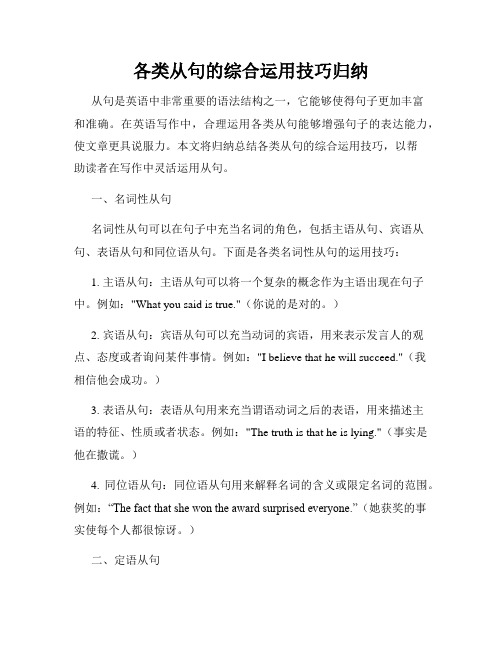
各类从句的综合运用技巧归纳从句是英语中非常重要的语法结构之一,它能够使得句子更加丰富和准确。
在英语写作中,合理运用各类从句能够增强句子的表达能力,使文章更具说服力。
本文将归纳总结各类从句的综合运用技巧,以帮助读者在写作中灵活运用从句。
一、名词性从句名词性从句可以在句子中充当名词的角色,包括主语从句、宾语从句、表语从句和同位语从句。
下面是各类名词性从句的运用技巧:1. 主语从句:主语从句可以将一个复杂的概念作为主语出现在句子中。
例如:"What you said is true."(你说的是对的。
)2. 宾语从句:宾语从句可以充当动词的宾语,用来表示发言人的观点、态度或者询问某件事情。
例如:"I believe that he will succeed."(我相信他会成功。
)3. 表语从句:表语从句用来充当谓语动词之后的表语,用来描述主语的特征、性质或者状态。
例如:"The truth is that he is lying."(事实是他在撒谎。
)4. 同位语从句:同位语从句用来解释名词的含义或限定名词的范围。
例如:“The fact that she won the award surprised everyone.”(她获奖的事实使每个人都很惊讶。
)二、定语从句定语从句用来修饰名词,并且必须紧跟在所修饰的名词之后。
下面是定语从句的运用技巧:1. 关系代词引导的定语从句:关系代词可指人也可指物,包括who, whom, that, which等。
例如:"The book that I borrowed from the library is very interesting."(我从图书馆借的那本书非常有趣。
)2. 关系副词引导的定语从句:关系副词在定语从句中充当连接副词的角色,包括where, when, why等。
各类从句讲解与例句

英语中六大从句用法总结1.主语从句1)主语从句可直接位于主语的位置,如果从句较长,谓语又较短,可用it作形式主语,而将从句放在句末。
常见的句型有:*It is a fact\a pity\a question\good news that...*It seems\appears\happened\has turned out that...*It is clear\important\likely\possible that...*It is said\reported\estimated\has been proved that...It is said that comic books create a connection between people of the same generation.It seems that the performance is very useful.2)what引导的主语从句表示“...的东西时”,一般不用it作形式主语。
What we lack is experience.3)what,who,when,why,whether等词含有各自的疑问意义,但它们引导的主语从句,都用陈述语序。
How the plan is to be carried out should be discussed again.I did know why I felt like crying.2.宾语从句1)宾语从句可位于及物动词、介词和某些形容词后。
连词that常可省略。
介词后一般接疑问词引导的宾语从句。
in that(因为),except that(除了),but that(只是)已构成固定搭配,其他介词后一般不接that引导的宾语从句。
*I promised that I would change the situation.*All this is different from what American young people would say about friendship.*He is certain that watching so much television is not good for children.*This article is well-written except that it is a bit too long.2)非谓语动词之后的宾语从句Reading that it was just a difference in custom, the foreigner smiled and said nothing. 这个外国人知道了这只是风俗的不同后,就笑了笑,没说什么。
高中英语中六大从句用法总结

高中英语中六大从句用法总结Summary: This article discusses the six major types of subordinate clauses in English。
including subject clauses and object clauses。
It provides examples and tips on how to use them correctly.1.Subject ClausesA XXX in the subject n。
If the clause is long and the predicate is short。
"it" can be used as a formal subject。
and the clause can be placed at the end of the sentence。
Common sentence structures include:It XXX。
It XXX。
It XXX。
It is said\XXX。
For example。
"It is said that comic books create a n een people of the same n." or "It seems that the performance is very useful."2.Object ClausesAn object clause XXX。
n。
or XXX "that" XXX word is usually used to introduce an object XXX such as "in that," "except that," and "but that" can also be used。
英语六大从句用法总结
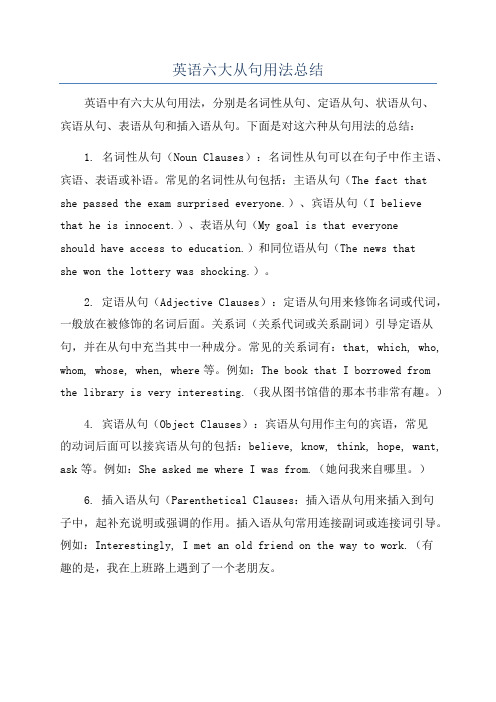
英语六大从句用法总结英语中有六大从句用法,分别是名词性从句、定语从句、状语从句、宾语从句、表语从句和插入语从句。
下面是对这六种从句用法的总结:1. 名词性从句(Noun Clauses):名词性从句可以在句子中作主语、宾语、表语或补语。
常见的名词性从句包括:主语从句(The fact that she passed the exam surprised everyone.)、宾语从句(I believe that he is innocent.)、表语从句(My goal is that everyoneshould have access to education.)和同位语从句(The news thatshe won the lottery was shocking.)。
2. 定语从句(Adjective Clauses):定语从句用来修饰名词或代词,一般放在被修饰的名词后面。
关系词(关系代词或关系副词)引导定语从句,并在从句中充当其中一种成分。
常见的关系词有:that, which, who, whom, whose, when, where等。
例如:The book that I borrowed from the library is very interesting.(我从图书馆借的那本书非常有趣。
)4. 宾语从句(Object Clauses):宾语从句用作主句的宾语,常见的动词后面可以接宾语从句的包括:believe, know, think, hope, want, ask等。
例如:She asked me where I was from.(她问我来自哪里。
)6. 插入语从句(Parenthetical Clauses:插入语从句用来插入到句子中,起补充说明或强调的作用。
插入语从句常用连接副词或连接词引导。
例如:Interestingly, I met an old friend on the way to work.(有趣的是,我在上班路上遇到了一个老朋友。
完整版英语从句用法总结

It was a great achievement to complete a 24-story building in 10 months.
固定用法和译法: (1) It is +名词+从句 It is a fact that… 事实是…… It is good news that … ……是好消息 It is a question that … ……是个问题 It is common knowledge that … ……是常识 类似的名词还有:a pity,a wonder,surprise,no wonder等.
2.由连接代词who,that引导;
What we lack is experience. Who will go to the energy conference is not important.
3.由连接副词when,how,where,why引导;
How he manages to finish the job is of interest to us. Why he failed the english exam wasn't clear.
The problem is when we can get a pay rise.
结构:主语 + 连系动词(be,seem,look) + 句子作表语 (1) 从属连词that,whether, as, as if 等;
The trouble is that I have lost his address.
I insist that she (should) do her work alone.
The commander ordered that troops (should) set off at once.
(完整版)英语语法英语从句完全汇总

英语语法: 英语从句完全汇总一.主语从句主语从句是在复合句中充当主语的从句,通常放在主句谓语动词之前或由形式主语it 代替,而本身放在句子末尾。
1. It 作形式主语和it引导强调句的比较It 作形式主语代替主语从句,主要是为了平衡句子结构,主语从句的连接词没有变化。
而it引导的强调句则是对句子某一部分进行强调,无论强调的是什么成分,都可用连词that。
被强调部分指人是也可用who/whom。
例如:It is a pity that you didn’t go to see the film.It doesn’t interest me whether you succeed or not.It is in the morning that the murder took place.It is John that broke the window.2. 用it 作形式主语的结构(1) It is +名词+从句It is a fact that …事实是…It is an honor that …非常荣幸It is common knowledge that …是常识(2) it is +形容词+从句It is natural that…很自然…It is strange that…奇怪的是…(3) it is +不及物动词+从句It seems that…似乎…It happened that…碰巧…(4) it +过去分词+从句It is reported that…据报道…It has been proved that…已证实…3. 主语从句不可位于句首的五种情况(1) if 引导的主语从句不可居于复合句句首。
(2) It is said , (reported) …结构中的主语从句不可提前。
例如:It is said that President Jingo will visit our school next week. (right)That President Jiang will visit our school next week is said. (wrong)(3) It happens…, It occurs…结构中的主语从句不可提前。
英语中总共有六大从句区分方法

英语中总共有六大从句,区分方法,用法,及例子如下:1.主语从句1)主语从句可直接位于主语的位置,如果从句较长,谓语又较短,可用it作形式主语,而将从句放在句末.常见的句型有:*It is a fact\a pity\a question\good news that...*It seems\appears\happened\has turned out that...*It is clear\important\likely\possible that...*It is said\reported\estimated\has been proved that...It is said that comic books create a connection between people of the same generation.It seems that the performance is very useful.2)what引导的主语从句表示“...的东西时”,一般不用it作形式主语.What we lack is experience.3)what,who,when,why,whether等词含有各自的疑问意义,但它们引导的主语从句,都用陈述语序.How the plan is to be carried out should be discussed again.I did know why I felt like crying.2.宾语从句1)宾语从句可位于及物动词、介词和某些形容词后.连词that常可省略.介词后一般接疑问词引导的宾语从句.in that(因为),except that(除了),but that(只是)已构成固定搭配,其他介词后一般不接that引导的宾语从句.*I promised that I would change the situation.*All this is different from what American young people would say about friendship.*He is certain that watching so much television is not good for children.*This article is well-written except that it is a bit too long.2)宾语从句后如有宾补,要用形式宾语it来代替,而把宾语从句移至宾补之后.He has made it clear that he would not change his mind.3)在think,believe,suppose,expect等动词后的宾语从句中,如果谓语是否定的,一般将否定词移至主句谓语上,宾语从句则变成肯定形式.He didn't think that the money was well spent.3.表语从句表语从句出现在结构为“主语+系动词+表语从句”的句子中.表语从句除可用that,what,when,why,whether,how等引导外,还可由because,as if(though)等引导.that常可省略.如主句主语为reason,只能用that引导表语从句,不可用because.Perhaps the most important thing to remember is that there is no one common type of life in America.The reason why so many people died there is that there were not enough food supplies.It looks as if successful international cultural communication will make the world smaller.4.同位语从句同位语从句用于对前面出现的名词作进一步说明,一般用连词that引导,由于先行名词的意义不同,也可用whether,who,when,where,what,why,how等引导.常见的先行名词有fact,idea,belief,news,hope,conclusion,evidence,suggestion,order,problem,report,decision.有时由于谓语较短,将同位语从句位于谓语之后.She finally made the decision that she would join the fashion show.I had no idea how many books I could borrow at a time.The news came that their team had won the championship.5.定语从句定语从句所修饰的先行词可以是名词或代词,也可以是一个句子.定语从句通常位于先行词之后,由关系代词或关系副词引导.*限制性定语从句限制性定语从句修饰先行词,对先行词起修饰作用,紧接先行词之后,无逗号,若省去,原句意思不完整.引导定语从句的关系代词有who,whom,whose,which,that等.who,whom,whose用于指人,whose有时也可指物,相当于of which;which用于指物;that既可指人也可指物,但只用于限制性定语从句中.关系代词除了引导定语从句,替代先行词外,还在从句中担任主语、宾语、定语等.The computers and cables which make up the Internet are owned by people and organizations. Those who live alone or who are sick may have trouble in getting close to other people.The girl whose parents died in an accident is living with her grandmother.1)当先行词是all,anything,everything,something,nothing等不定代词或先行词前有first,last,any,few,much,some,no,only以及形容词最高级修饰时,只能用关系代词that引导从句. That is all that I've heard from him.He's the first person that I'm going to interview this afternoon.2)关系代词的省略在从句中作宾语的关系代词常可省略.关系代词紧跟介词,作介词宾语时不可用that,只可用which或whom引导从句,并且不可省略,但当介词位于宾语从句句末时,作为介词宾语的关系代词仍可用that,也可省略.This is one of those things with which we have to put up.This is one of those things (which\that) we have to put up with.3)引导定语从句的关系副词有when,where,why等.关系副词在从句中作状语,意义上相当于一个“介词+which”的结构.Even in comic books where(=in which) there are no words,the stories are fully expressed through the drawings.No one knows the reason why(=for which) he was so angry that day.5.定语从句*非限制性定语从句非限制性定语从句既可修饰先行词,也可修饰整个主句,起补充说明作用,与主句之间有逗号隔开,若省去,原句意思不受影响.不可用that引导非限制性定语从句.关系词不可省略. Every object has a gravitational pull,which is rather like magnetism.*“介词+which\whom\whose”引导的定语从句“介词+which\whom\whose”可引导限制性定语从句,也可引导非限制性定语从句,该结构中介词的选择取决于从句谓语动词的固定搭配,或先行词的习惯搭配.This is the computer on which he spent all his savingsIt is written by a person with whom we are all familiar.*as引导的定语从句as引导的定语从句主要用于“such...as”及“the same...as”的结构中,代替先行词是人或物的名词.as引导非限制性定语从句时,代替整个主句,从句可位于主句之前、之后或中间.These are not such problems as can be easily solved.(as代替先行词problems)As is mentioned above,no single company or group can control what happens on the Internet.(as 代替主语)6.状语从句*时间状语从句引导时间状语从句的从属连词和词组有:1)when,whenever,while,as,after,before,since,till,until,once等.We have learnt quite a lot about it since we came here.2)as soon as,hardly(scarcely)...when,no sooner...than,each(every) time,the moment,immediately(that)等.As soon as I sent an e-mail message,I received positive responses.The moment he heard the good news,he jumped with joy.*地点状语从句引导地点状语从句的连词是where,wherever.Wherever she went,she took her little daughter with her.*原因、结果和目的状语从句1)引导原因状语从句的从属连词有:because,as,since,now(that),seeing that,considering that,in that等.Considering that he is a freshman,we must say he is doing well.2)引导结果状语从句的连词有:so...that,such...that,so that,that,so等.Mickey Mouse is so attractive that the children are reluctant to leave.3)引导目的状语从句的连词有:so that,in order that,for fear that,lest等,从句常使用may,might,can,could,would等情态动词.We got up early this morning so that we could catch the first bus to the railway station.*条件和让步状语从句1)引导条件状语从句的连词和词组有if,unless,as(so) long as,on condition that,in case,provided(providing) that,supposing等.As long as you have the right equipment,you can use a telephone line to transmit computer data.2)引导让步状语从句的连词和词组有though,although,whether,even though,even if,no matter what(when,how...),whatever(whenever,wherever,however.)等.though,even if等引导状语从句可转换成含有as的部分倒装结构,具有强调意义.其结构为“形容词(副词、动词、名词)+as+主语+谓语”.No matter what you may say,I would not change my mind.Young as he is,he is quite experienced in this work.(=though he is young)Child as he is,he can speak English fluently.(=though he is a child)*方式状语从句引导方式状语从句的连词有as,just as,as if,as though等.as if,as though引导的状语从句中,谓语动词常用虚拟语气,表示与事实相反.The young man made the experiment just as the teacher had taught him.Everything went on as usual as if nothing had happened.。
六大从句用法总结

定语从句 page7
状语从句
时间状语从句 引导时间状语从句的从属连词和词组有: 1)when,whenever,while,as,after,before,since,till,until,once等. *We have learnt quite a lot about it{ since we came here}. 2)as soon as,hardly(scarcely)...when,no sooner...than,each(every) time,the moment,immediately(that)等. *{As soon as I sent an e-mail message},I received positive responses. *{The moment he heard the good news},he jumped with joy.
定语从句 page1
定语从句
• 限制性定语从句 限制性定语从句修饰先行词,对先行词起修饰作用,紧接先行词之后, 无逗号,若省去,原句意思不完整. 引导定语从句的关系代词有who,whom,whose,which,that等. who,whom,whose用于指人,whose有时也可指物,相当于of which; which用于指物; that既可指人也可指物,但只用于限制性定语从句中.关系代词除了 引导定语从句,替代先行词外,还在从句中担任主语、宾语、定语等.
状语从句 page1
状语从句
地点状语从句 引导地点状语从句的连词是where,wherever. *{Wherever she went},she took her little daughter with her. 原因、结果和目的状语从句 1)引导原因状语从句的从属连词有:because,as,since,now(that),seeing that,considering that,in that等. {Considering that he is a freshman},we must say he is doing well. 2)引导结果状语从句的连词有:so...that,such...that ,so that,that,so等. Mickey Mouse is so attractive{ that the children are reluctant to leave}.
- 1、下载文档前请自行甄别文档内容的完整性,平台不提供额外的编辑、内容补充、找答案等附加服务。
- 2、"仅部分预览"的文档,不可在线预览部分如存在完整性等问题,可反馈申请退款(可完整预览的文档不适用该条件!)。
- 3、如文档侵犯您的权益,请联系客服反馈,我们会尽快为您处理(人工客服工作时间:9:00-18:30)。
英语中六大从句用法总结1.主语从句1)主语从句可直接位于主语的位置,如果从句较长,谓语又较短,可用it作形式主语,而将从句放在句末。
常见的句型有:*It is a fact\a pity\a question\good news that...*It seems\appears\happened\has turned out that...*It is clear\important\likely\possible that...*It is said\reported\estimated\has been proved that...It is said that comic books create a connection between people of the same generation.It seems that the performance is very useful.2)what引导的主语从句表示“...的东西时”,一般不用it作形式主语。
What we lack is experience.3)what,who,when,why,whether等词含有各自的疑问意义,但它们引导的主语从句,都用陈述语序。
How the plan is to be carried out should be discussed again.I did know why I felt like crying.2.宾语从句1)宾语从句可位于及物动词、介词和某些形容词后。
连词that常可省略。
介词后一般接疑问词引导的宾语从句。
in that(因为),except that(除了),but that(只是)已构成固定搭配,其他介词后一般不接that引导的宾语从句。
*I promised that I would change the situation.*All this is different from what American young people would say about friendship.*He is certain that watching so much television is not good for children.*This article is well-written except that it is a bit too long.2)宾语从句后如有宾补,要用形式宾语it来代替,而把宾语从句移至宾补之后。
He has made it clear that he would not change his mind.3)在think,believe,suppose,expect等动词后的宾语从句中,如果谓语是否定的,一般将否定词移至主句谓语上,宾语从句则变成肯定形式。
He didn't think that the money was well spent.3.表语从句表语从句出现在结构为“主语+系动词+表语从句”的句子中。
表语从句除可用that,what,when,why,whether,how等引导外,还可由because,as if(though)等引导。
that常可省略。
如主句主语为reason,只能用that引导表语从句,不可用because.Perhaps the most important thing to remember is that there is no one common type of life in America.The reason why so many people died there is that there were not enough food supplies.It looks as if successful international cultural communication will make the world smaller.4.同位语从句同位语从句用于对前面出现的名词作进一步说明,一般用连词that引导,由于先行名词的意义不同,也可用whether,who,when,where,what,why,how等引导。
常见的先行名词有fact,idea,belief,news,hope,conclusion,evidence,suggestion,order,problem,report,decision.有时由于谓语较短,将同位语从句位于谓语之后。
She finally made the decision that she would join the fashion show.I had no idea how many books I could borrow at a time.The news came that their team had won the championship.5.定语从句定语从句所修饰的先行词可以是名词或代词,也可以是一个句子。
定语从句通常位于先行词之后,由关系代词或关系副词引导。
*限制性定语从句限制性定语从句修饰先行词,对先行词起修饰作用,紧接先行词之后,无逗号,若省去,原句意思不完整。
引导定语从句的关系代词有who,whom,whose,which,that等。
who,whom,whose 用于指人,whose有时也可指物,相当于of which;which用于指物;that既可指人也可指物,但只用于限制性定语从句中。
关系代词除了引导定语从句,替代先行词外,还在从句中担任主语、宾语、定语等。
The computers and cables which make up the Internet are owned by people and organizations.Those who live alone or who are sick may have trouble in getting close to other people.The girl whose parents died in an accident is living with her grandmother.1)当先行词是all,anything,everything,something,nothing等不定代词或先行词前有first,last,any,few,much,some,no,only以及形容词最高级修饰时,只能用关系代词that引导从句。
That is all that I've heard from him.He's the first person that I'm going to interview this afternoon.2)关系代词的省略在从句中作宾语的关系代词常可省略。
关系代词紧跟介词,作介词宾语时不可用that,只可用which或whom引导从句,并且不可省略,但当介词位于宾语从句句末时,作为介词宾语的关系代词仍可用that,也可省略。
This is one of those things with which we have to put up.This is one of those things (which\that) we have to put up with.3)引导定语从句的关系副词有when,where,why等。
关系副词在从句中作状语,意义上相当于一个“介词+which”的结构。
Even in comic books where(=in which) there are no words,the stories are fully expressed through the drawings.No one knows the reason why(=for which) he was so angry that day.5.定语从句*非限制性定语从句非限制性定语从句既可修饰先行词,也可修饰整个主句,起补充说明作用,与主句之间有逗号隔开,若省去,原句意思不受影响。
不可用that引导非限制性定语从句。
关系词不可省略。
Every object has a gravitational pull,which is rather like magnetism.*“介词+which\whom\whose”引导的定语从句“介词+which\whom\whose”可引导限制性定语从句,也可引导非限制性定语从句,该结构中介词的选择取决于从句谓语动词的固定搭配,或先行词的习惯搭配。
This is the computer on which he spent all his savingsIt is written by a person with whom we are all familiar.*as引导的定语从句as引导的定语从句主要用于“such...as”及“the same...as”的结构中,代替先行词是人或物的名词。
as引导非限制性定语从句时,代替整个主句,从句可位于主句之前、之后或中间。
These are not such problems as can be easily solved.(as代替先行词problems)As is mentioned above,no single company or group can control what happens on the Internet.(as代替主语)6.状语从句*时间状语从句引导时间状语从句的从属连词和词组有:1)when,whenever,while,as,after,before,since,till,until,once等。
We have learnt quite a lot about it since we came here.2)as soon as,hardly(scarcely)...when,no sooner...than,each(every) time,the moment,immediately(that)等。
As soon as I sent an e-mail message,I received positive responses.The moment he heard the good news,he jumped with joy.*地点状语从句引导地点状语从句的连词是where,wherever.Wherever she went,she took her little daughter with her.*原因、结果和目的状语从句1)引导原因状语从句的从属连词有:because,as,since,now(that),seeing that,considering that,in that等。
